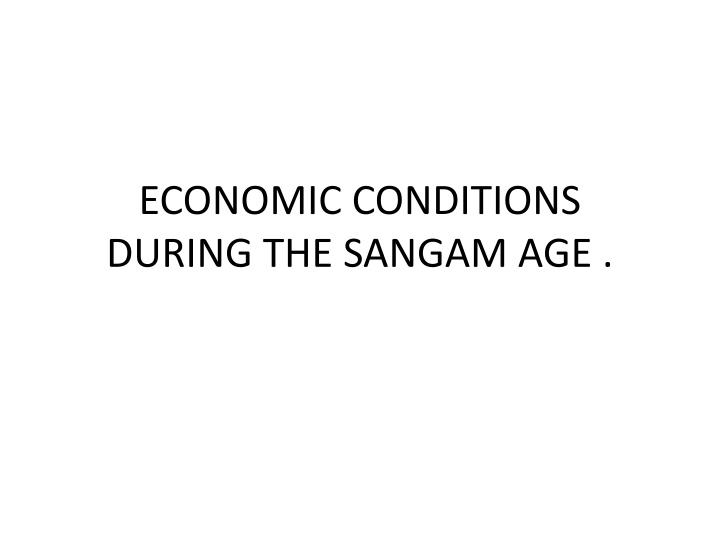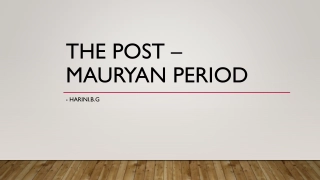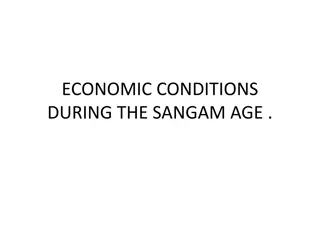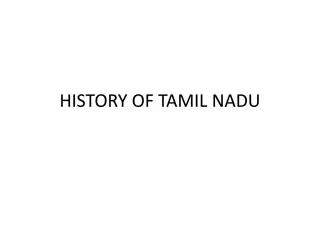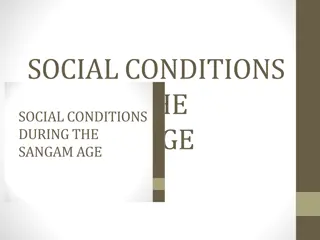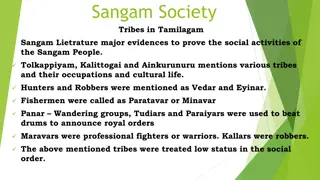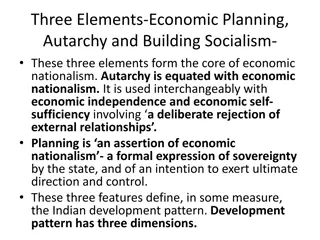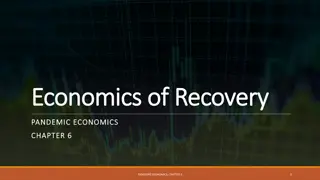Economic Conditions During the Sangam Age
Agriculture was the main occupation with paddy as the main crop. Industries like weaving and spinning flourished producing cotton fabrics and fine garments. Fishing and hunting were important occupations, and trade was well-organized internally and externally, transitioning from barter to coin systems. Local markets and ports facilitated commercial activities, with Roman traders present in Tamil Nadu. The Sangam age saw a thriving economy based on agriculture, crafts, trade, and commerce.
Download Presentation

Please find below an Image/Link to download the presentation.
The content on the website is provided AS IS for your information and personal use only. It may not be sold, licensed, or shared on other websites without obtaining consent from the author.If you encounter any issues during the download, it is possible that the publisher has removed the file from their server.
You are allowed to download the files provided on this website for personal or commercial use, subject to the condition that they are used lawfully. All files are the property of their respective owners.
The content on the website is provided AS IS for your information and personal use only. It may not be sold, licensed, or shared on other websites without obtaining consent from the author.
E N D
Presentation Transcript
ECONOMIC CONDITIONS DURING THE SANGAM AGE .
Agriculture The chief occupation of the people was agriculture . Paddy was the main crop . Rice was the common crop and ragi , sugar cane , cotton , pepper , ginger , turmeric and a variety of fruits were the other crops , Jack Fruits and Pepper were famous in the Chera country . Millet , grams and sugarcane were also cultivated . Irrigation through Rivers , Tanks and Wells were used for cultivation .
Industries Weaving and spinning were the most important crafts of the Sangam period . Uraiyur and Madurai were the main centres for the manufacture of Cotton fabrics . The weavers produced and exported fine cotton clothes . The handicrafts of the Sangam period were popular , weaving , Metal works and Carpentry , Ship building and making of ornaments using beads , stones and ivory . The word Kalingam refers to very nice garments . The Sangam literature refers to clothes , which were thinner than steam . Silk clothes were also produced in the Tamil country . Other Craftsmen like the Carpenter , Blacksmith , Goldsmith and Potter had practised their respective occupations.
Fishing and hunting had remained as an important occupation during the Sangam period . There was a great demand for these products , as the internal and external trade was at its peak during the Sangam period . There was a great demand in the western world for the cotton clothes woven at Uraiyur . Trade and Commerce . Both internal and external trade was well organised during the Sangam Age . The Sangam Literature , Greek and Roman accounts and the Archaeological evidences provide detailed information on this subject. In the beginning of the Sangam Age the Barter system of trade was followed . The people of Kurinji region exchanged honey with the people of Neydal region for getting fish and Salt . The Mullai people gave their milk products to Marudham people to get rice from them . Later , when they began to use Coins , trade picked up rapidly .
Local markets came up and they were known as Angadis . Both Day Market ( Nalangadi )and Evening Bazar ( Allangadi ) existed in port towns . The Pattinappalai refers to their existence at Puhar , Goods from distant places were brought to these markets . Merchants carried the goods on the Carts and on animal back from place to place . Internal trade was mostly based on the Barter system . External trade was carried between South India and the Greek Kingdoms The port city of Puhar became an emporium of foreign trade , as big ships entered this port with precious goods . Other ports of commercial activity include Tondi , Musiri , Korkai , Arikkamedu and Marakkanam .
Plenty of Gold coins issued by the Roman Emperors like Augustus , Tiberius and Nero were in all parts of Tamil Nadu They reveal the extent of the trade and the presence of Roman traders in the Tamil country . The main exports of the Sangam age were Cotton fabrics , Spices like Pepper , Ginger , Cardamom , Cinnamon and turmeric , Ivory products , Pearls and Precious stones . Gold , Horses and Sweet wine were the chief imports . ____________.
